The Fastest County in America

Right in the middle of Kannapolis, North Carolina, not far from where V-8 Street, Sedan Avenue, and Cadillac Street converge, lies a loop of connected one-way roads all named West Avenue. This is an unhurried street crowded with well-maintained one- and two-story brick buildings surrounding a dense boulevard dominated by willow oaks and angled parking spaces. But locals who were around back in the mid-20th century remember something rowdier: restaurants, movie theaters, and the stretch of West Avenue still colloquially called Idiot Circle.
The old-timers say that Idiot Circle is where the late Dale Earnhardt, arguably the greatest of North Carolina's long line of professional race car drivers, first learned the art of racing. As a teenager, the Intimidator practiced a simple routine: Cruise Idiot Circle. Find someone to race with. Hit the accelerator. Go left. Go left. Go left again.
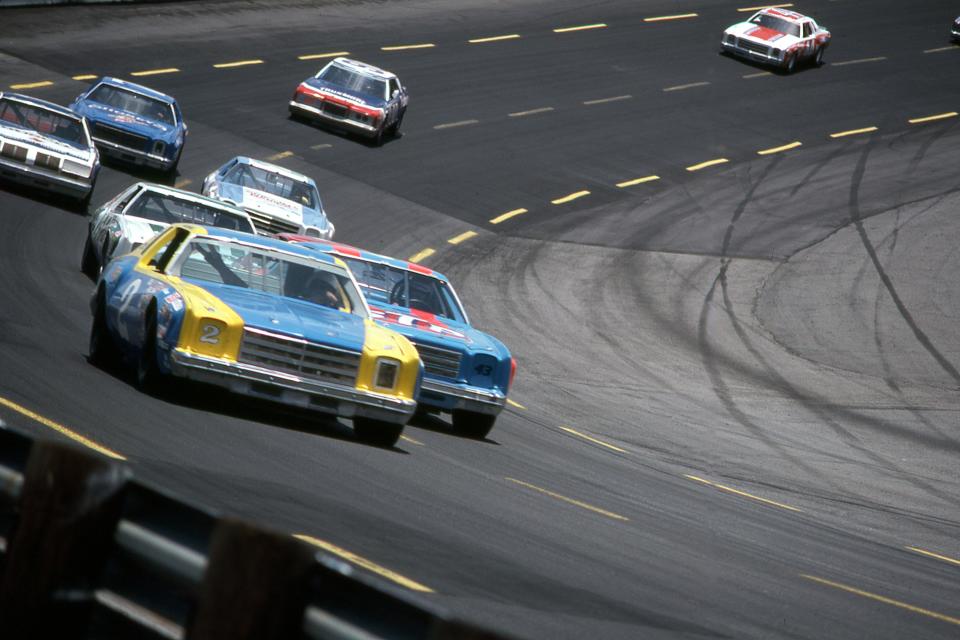
The man himself now surveys his old racing grounds. Half a block away in the center of the Dale Earnhardt Tribute Plaza stands a nine-foot-tall bronze statue of Earnhardt, smiling as he looks to the southeast toward the circle. He towers nearby as I find myself chatting with Gregg Dayvault, Earnhardt's childhood friend and racing buddy. Leaning against the fender of his immaculate 1935 Ford, Dayvault can't help but dispense car advice. "You should always feel your gasoline before you put it in your tank," he says. "Drip a little on your fingertips, and rub them together. If it feels gummy, then somebody just dumped in [additives] and they didn't mix in well. That'll ruin your seals and O-rings."
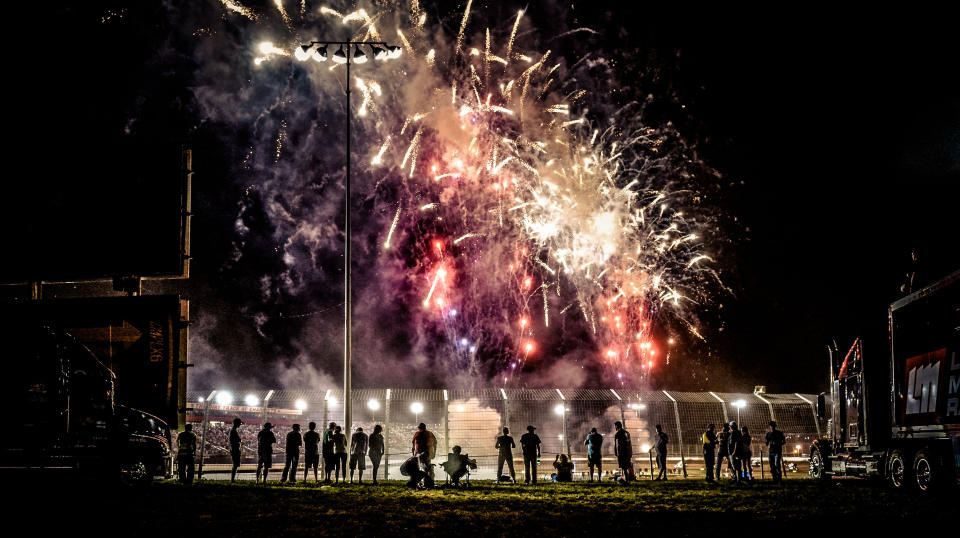
Cars run in this man's blood, regular cars, race cars, "liquor cars." Let him keep reminiscing in that inland Southern drawl and he'll take you back to a different Kannapolis-the days before stock car racing was huge national-television contracts and giant corporate sponsorships. Before he worked on Earnhardt's first racing car, Dayvault was one of the car buffs who cruised the town streets with Earnhardt on Saturday nights. The man known as one of the most aggressive drivers in racing history-the man called "the Intimidator"-initially drove a decidedly nonintimidating cotton-candy-pink Ford.
"Dale's neighbors gave him a 1956 Ford to race," Dayvault tells me. "He didn't have enough red paint to cover the entire car, so they mixed it with some other paint and it came out pink." Evidently Earnhardt didn't care much. They went ahead and painted "Dayvault's Tune Up Service" on the side and raced it on local dirt tracks.
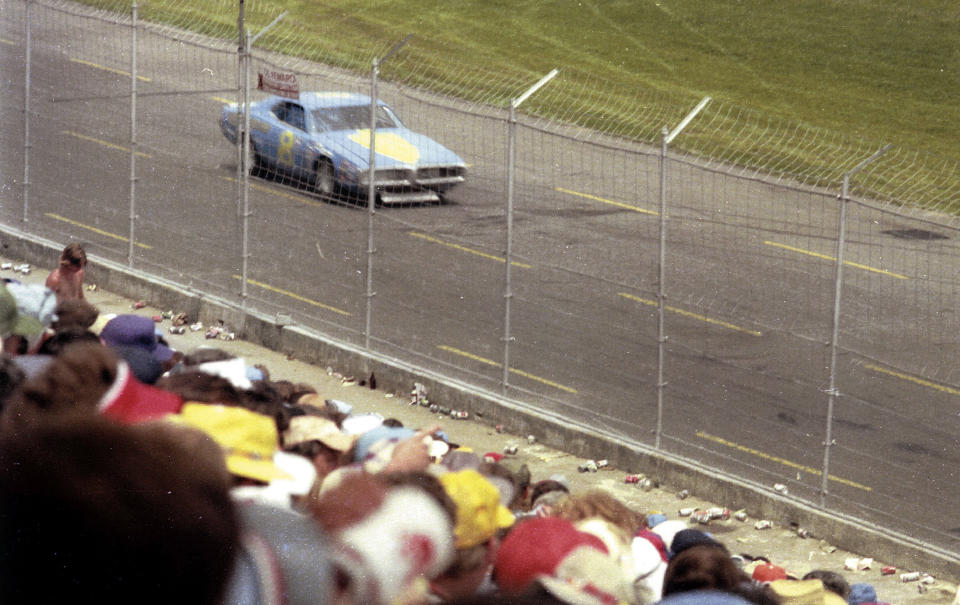
During Earnhardt's racing days, Kannapolis was the home of Cannon Mills, a textile maker, and this was a company town. In the second half of the 20th century, though, few industries shrank as far and as fast as textiles. Kannapolis had to remake itself. The new economic engine driving the city is high-tech research, with a consortium of universities building new facilities on the grounds where the mills once stood.
Yet you can still feel the ghosts of old Kannapolis. Drive around a bit and you'll spot the small, plain houses the mills built to house workers, and hear the echoes of street racing and dirt tracks and Idiot Circle. The smell of burnt rubber and broken laws.
Red Dirt Road
There are far more Porsches and Ferraris in Los Angeles, and many people think Bostonians drive like they're racing to the hospital with a woman in labor. Cabarrus County, North Carolina, is definitely not a hotbed for imported European supercars, nor is it in a big damn Northeastern hurry. But it makes as good a claim as any to be the fastest county in the USA. This is the mecca of going way too fast. This is carburetor country.
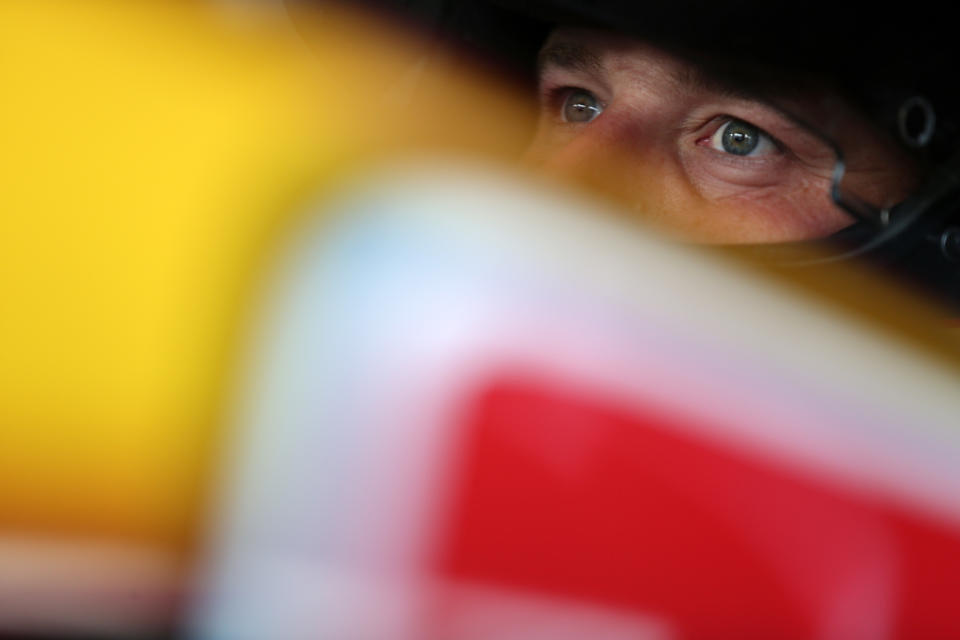
America's favorite kind of car racing, the NASCAR Sprint Cup Series, has produced 28 different champions. Nine of them hail from Cabarrus and its close surroundings. Early on there was Buck Baker, the first champion with back-to-back titles. After him came Lee Petty, the first driver to win three championships. Richard Petty, from nearby Randolph, North Carolina, ruled the roost in the 1980s, followed by 1990s racing superstar Dale Earnhardt, Sr. Today, about 90 percent of the teams competing in NASCAR's top three series are based within a 100-mile radius of the Charlotte Motor Speedway.
"From the earliest days of auto racing, most of the best teams, drivers, and technology have moved here," says Lenny Batycki, director of communications at Charlotte Motor Speedway. "It's like Hollywood. That's where you find the best actors, film editors, and so on, because of the opportunity. It's similar in this area. Here is where you'll find the top professionals in the industry: the best chassis builders, best motor builders, best part fabricators, and the best drivers."
How did all this speed wind up here? The answer is under your feet. If you're standing in Cabarrus County and you don't see asphalt or blacktop, chances are you're standing on red clay. Known to geologists as ultisol, red clay is cakey and crumbly and a rusty ocher color. It's also fantastic for racing. "North Carolina's red clay is the perfect racing surface," says Buz McKim, the NASCAR Hall of Fame's official historian. "If it's properly treated (mixed, graded, compacted, and watered down), there's absolutely nothing better to race cars on."
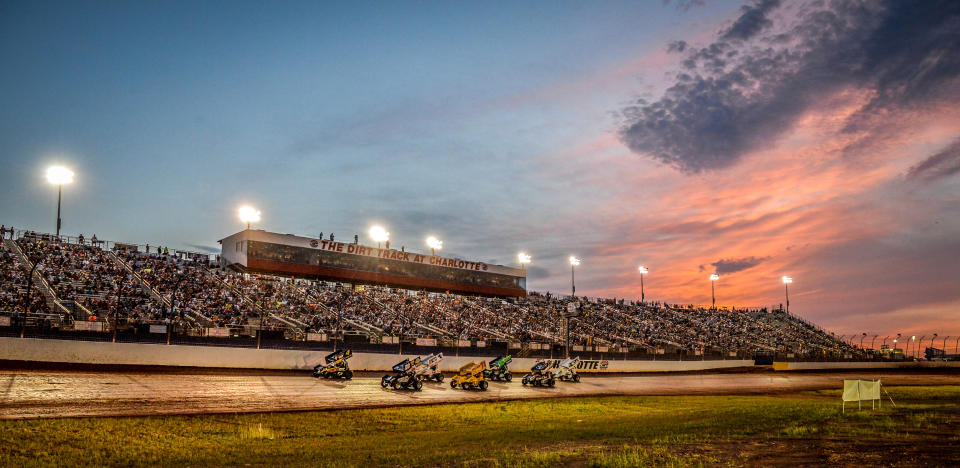
The clay was not always so prized. Compared to, say, Iowa loam or Washington State palouse, the soil of Cabarrus County is not particularly fertile. The North Carolinians who earned their living from the land had to work damn hard for their money. If there was another way to earn a few bucks, then the Tar Heels were motivated to find it. They did. Back in the 1930s, '40s, and '50s, this part of highland North Carolina was sparsely populated, reasonably suited for growing corn, and close to a lot of dry counties where there were no bars or liquor stores. A few enterprising rural types with more ambition than respect for the law decided to make and sell untaxed adult beverages. Moonshine.
"[Moonshining] knowledge and skills were passed down from generation to generation," says McKim, "Making the stuff was a way of life."
Of course, maintaining that lifestyle meant the moonshiners needed a way to move their product without getting arrested, which is how the history of illicit booze and stock car racing came to be intertwined. Rather than figuring out elaborate ways of sneaking past federal agents and their dragnets, many whiskey runners took a direct approach: They would simply go faster than the police cars.
The best-known NASCAR driver who admits to bootlegging is Junior Johnson, one of the greatest drivers of the 1950s and 1960s. He won 50 NASCAR races before he retired in the mid-1960s. But Johnson was far from being the only bootlegger who turned his off-track-driving experience into something a bit more legit. University of North Carolina history professor Daniel Pierce, who has studied the history of the sport, explains that a great number of early-era racers were liquor runners.
"Many of the early NASCAR mechanics, car owners, promoters, and so on were involved in moonshine and bootlegging."
"It's not just an apocryphal story, and it wasn't just the drivers," he told me in a conversation at the Hall of Fame near a re-creation of Junior Johnson's still. "Many of the early NASCAR mechanics, car owners, promoters, and so on were involved in moonshine and bootlegging."
At first the typical moonshiner conveyance-or liquor car, as people like Gregg Dayvault still call them-was a prewar Ford coupe with extra-stiff springs, a modified carburetor, and a bored-out engine that could go like a bat out of hell, outrunning government agents in hot pursuit. Over time, the means outpaced the end. Moonshiners became better at making cars go fast than they were at making illegal corn whiskey. It didn't take long for one moonshiner to wonder whether his car was faster than his rival's. Races ensued. Soon more and more race drivers, car builders, and spectators got involved.
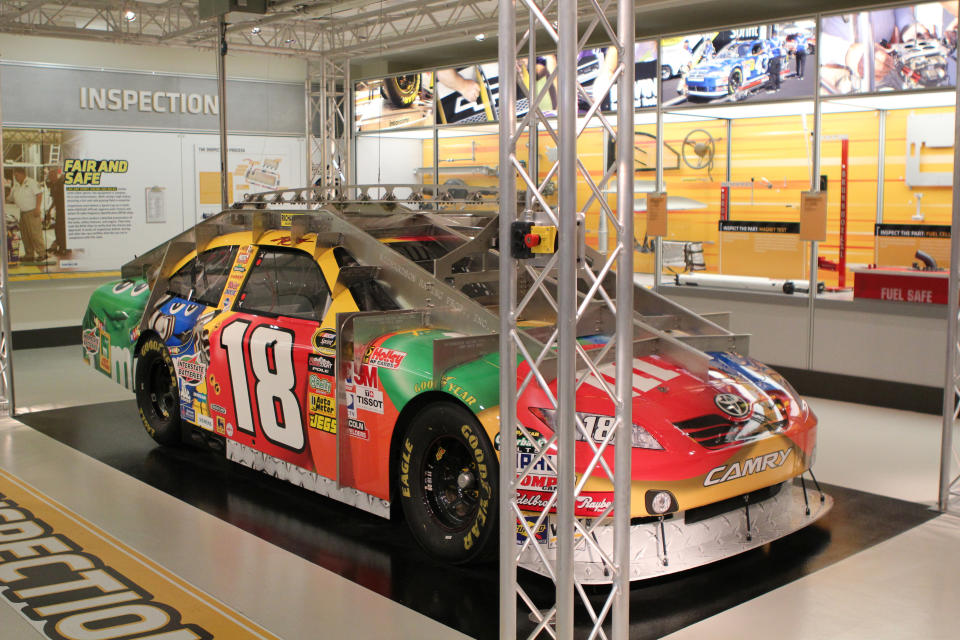
According to McKim, it was a former driver and part-time race promoter named Bill France who realized how big racing could be if it were organized and had a uniform set of rules. France thought the sport needed national standings and a single champion driver each year. In 1947, he organized a meeting of top drivers and car owners from across the country to draft a plan. What they came up with was the National Association for Stock Car Auto Racing, NASCAR. Since then the sport has never looked in the rearview mirror.
A Sport Among Games
The old quote attributed to Ernest Hemingway goes like this: "There are only three sports: bullfighting, motor racing, and mountaineering, all the others being games." I used to think that sitting in a cramped racing cockpit for a few hours and tugging at a steering wheel do not an athlete make. Heck, I've flown from L.A. to Sydney in coach class. That's 16 hours in a seat with 19 inches of butt clearance, and, while it's an ordeal, it doesn't make me an athlete. But this is a flawed analogy. Unless you've experienced it for yourself, the athleticism of auto racing is a bit difficult to understand. It's a combination of eye-hand coordination, stamina, concentration, and nerve. It can be appreciated best by climbing into the cockpit of a car with way too much power.
Of course, you can't become a NASCAR driver overnight. But, in Carburetor Country there are plenty of ways to live life at high speed.
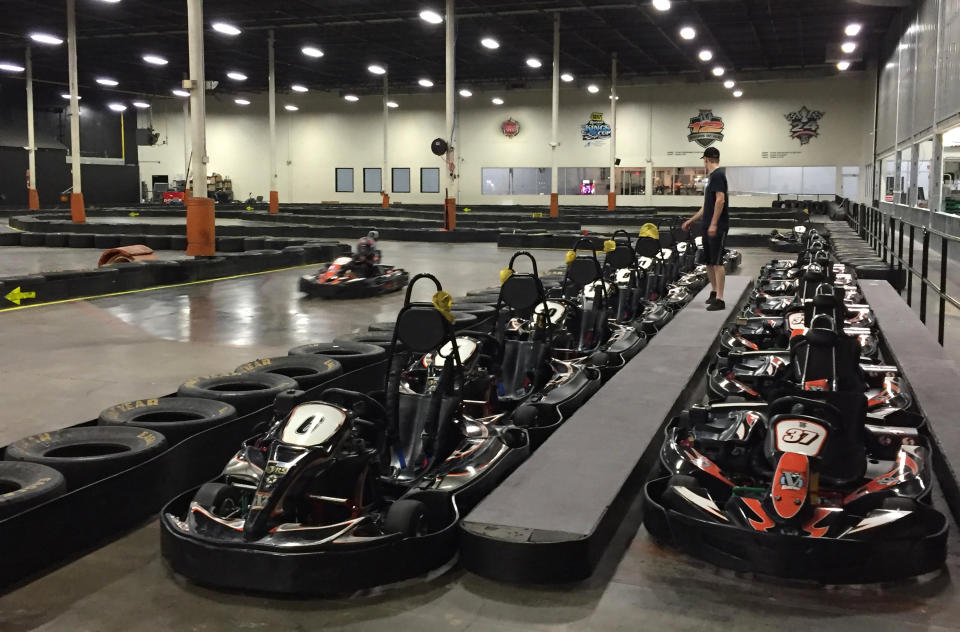
The World Karting Association is headquartered in Concord, North Carolina, in the shadow of the speedway. As you might expect in the motorsports-crazy South, there are several indoor and outdoor tracks nearby where you can race gasoline-powered karts. If you haven't experienced it, you might dismiss karting as kid's stuff. Don't. Go-karting is thrilling, and it's the way a lot of pro drivers, including Juan Pablo Montoya, Danica Patrick, and Tony Stewart, got started. Karting is racing, pure and simple, that is not only exciting but also safe and relatively cheap. And because the 9-hp 270-cc engine-equipped karts are all the same size and shape, success comes down to driving skill.
You've got to start somewhere, even if you're a middle-aged man rather than a seven-year-old kid like Stewart was when he started karting. So I drove to the Victory Lane kart track in the northeastern suburbs of Charlotte, put on my helmet, climbed into the seat, and harnessed in. I sized up my competition, consisting of four guys and two women. They were all younger than me, and it appeared they had done this sort of thing before.
Upon a wave of the start flag, we were off. For eight minutes, we lapped the track, braking in and out of tight turns and opening up through the straightaways, going nose to tail and wheel to wheel. While the 9-hp engine in the typical cart doesn't seem like much, it's plenty when you consider how little a kart weighs. Add to that the fact that you're seated only inches from the ground, and the perceived sensation of speed is much greater than what a radar gun would show.
Speed-and the sensation of flying around a course with your butt barely off the surface-is only a part of the racing experience. Experienced kart drivers, which I am not, understand that winning comes down to skillful control of the kart's momentum. My first few laps in a kart I gleefully skidded into the corners like a middle-aged Tokyo drift king. Later I wised up because that kind of driving scrubs speed. Turning and braking efficiently is the name of the game. You learn quickly not to plow into the turns at top speed and waste hard-earned momentum sliding into other karts and wall barriers once you start falling behind.
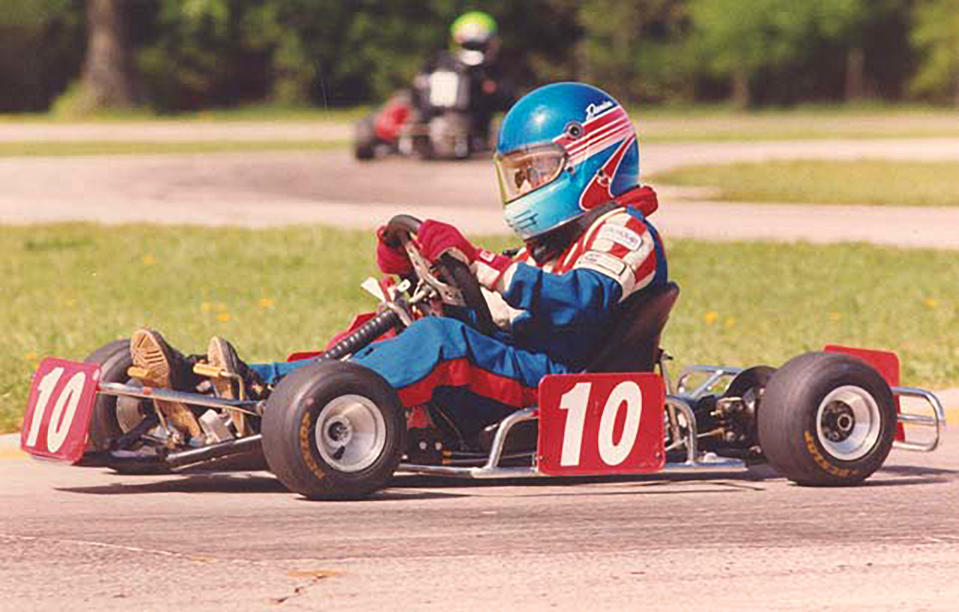
There are no downtimes during a kart race. Mastering my machine's momentum meant I had to constantly avoid stalled or bunkered karts and keep track of faster and slower traffic while turning, braking, and accelerating. I got better, but I couldn't come close to keeping up with the fastest racers. Let me tell you, getting lapped over and over bruises one's ego.
Later that day, I talked about the karting experience with Howard Hitchcock. He's the president of Lionel Racing, the company that manufactures licensed die-cast models of race cars. He's a guy who knows racing and has spent time in racing karts and other vehicles. His advice: Buck up and get some practice.
For eight minutes, we lapped the track, braking in and out of tight turns and opening up through the straightaways, going nose to tail and wheel to wheel.
"You've got to work your tail off to get the experience [that allows you] to come close to winning," he said. "I've raced in karts in charity events against pro drivers like Joey Logano and Jimmie Johnson. Even though they drive the exact same vehicle as you, they lap you. They just see things out there you can't. They do things you can't. When you race against them, you really appreciate how good they are."
Taking a Lap
About once or twice a month, regular people can drive the Charlotte Motor Speedway in a 600-hp stock car. It's called the Richard Petty Driving Experience. Racing Hall of Famer Petty and his partners cooked up the idea after he retired from racing about 25 years ago. RPDE offers a range of experiences, priced from a hundred dollars to a few thousand. All of them provide non-pros the thrill of playing NASCAR driver.
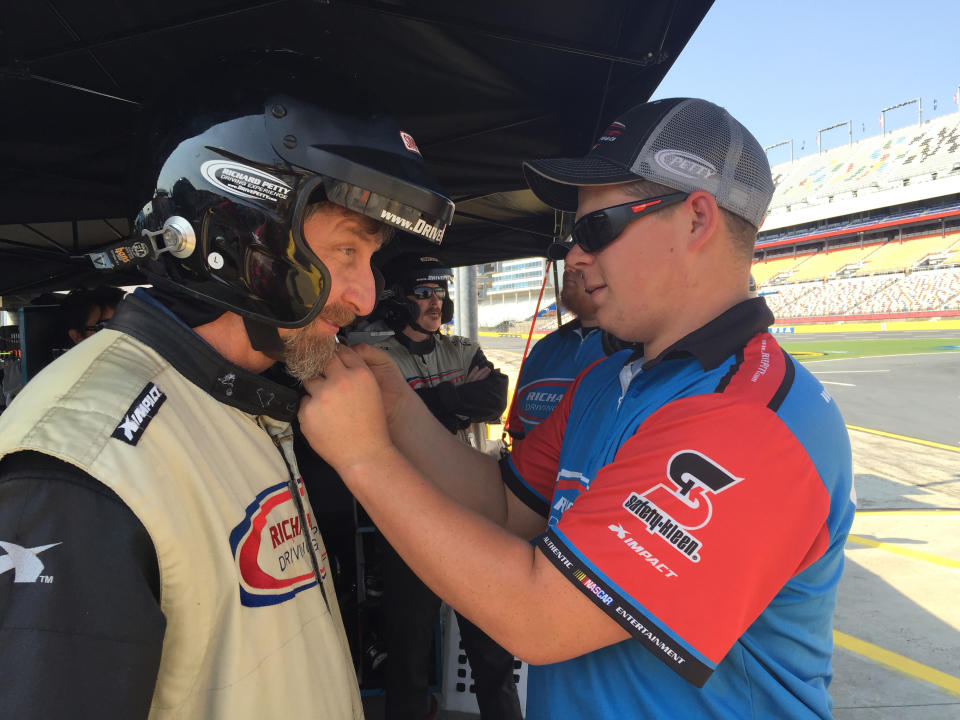
I donned a gray and black Nomex fire-resistant suit and black helmet and climbed through the passenger window of my ride, a clone of A. J. Allmendinger's No. 47 blue and orange Chevy with the words "Bush's Best Beans" emblazoned on the hood and fenders. Once you're inside, buckling in is a major operation, requiring the placement and adjustment of four or five different cross-body straps, culminating with the attachment of a head restraint known as a Hans device to my helmet.
Stock car fans know that despite the nominal Chevy-like appearance of the exterior, a NASCAR vehicle is a completely different beast. It's a fact that slaps you in the face when you're strapped in. Beyond having no glass in the side windows, the car's interior is a merely a metal shell surrounding a roll cage fabricated from welded steel tubes. There's no speedometer or muffler or wing mirrors. The expert driver promised me that we would "go real fast." Or something like that. Even at idle, the engine roar was so loud I couldn't really hear his name or anything else he said.
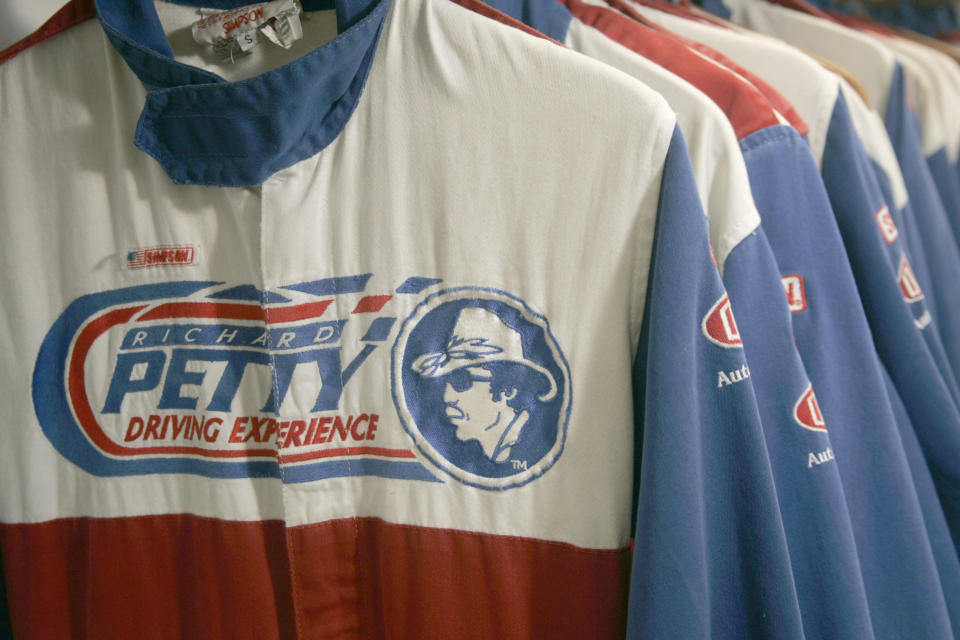
Once given the signal to proceed, we in car 47 accelerated out of the pit area, following another car through the middle of the track into the 24-degree-banked first and second turns. Then we really picked up steam on the long back straightaway before going high into Turn 3, moving within what looked to me like mere inches from the wall. In the turns, multiple G-forces pressed me hard into my seat. From what I could figure out by examining the video of my ride later on, we took about 37 seconds to complete a 1.5-mile lap, which works out to about 146 miles per hour. On the straightaways, I estimate we topped 170.
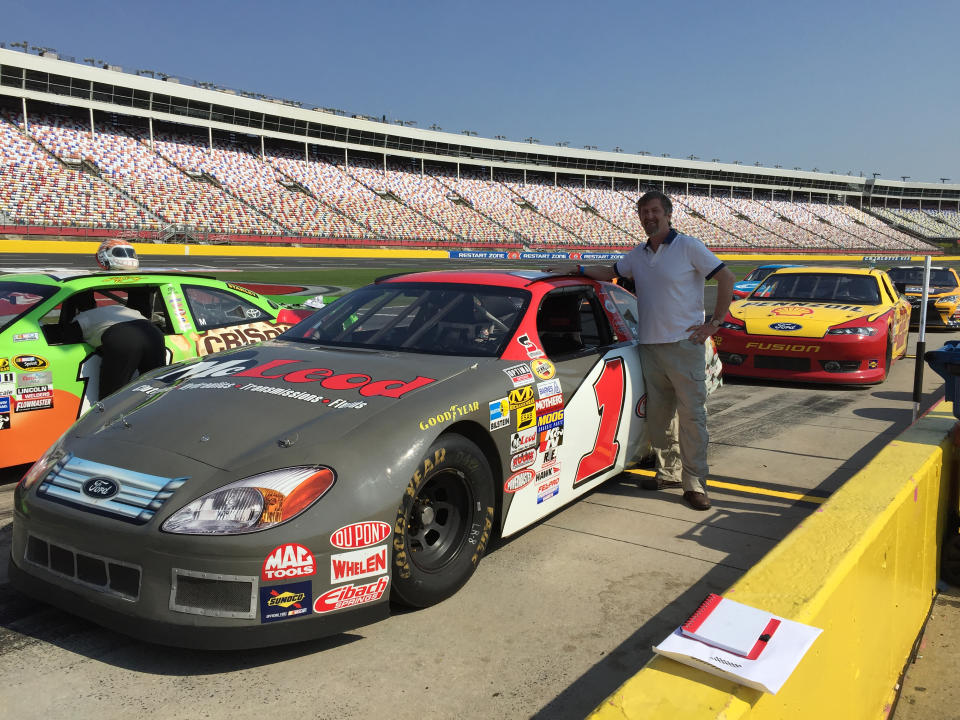
At high speed, the physical world is an uncomfortable place. Just sitting in the passenger seat of a speeding stock car was an exhausting, exhilarating barrage of sights, sounds, pressures, and forces on my body and brain. Handling all that while driving 400 laps in heavy traffic is what race car drivers routinely do.
Yeah, they are athletes.
NASCAR Mecca
There are $1.5 billions' worth of racing teams crammed into carburetor country. With that sort of dough, team owners can build shop facilities that are tourist attractions in themselves. It's not just about the race. Fans flock here to visit the race shops, the often palatial team headquarters where the cars are built and their pit crews train. "If you are a stock car fan, this place is your mecca," Performance Racing Network announcer Doug Rice told me. "Everything is in one place. You get to see way more than just the race."
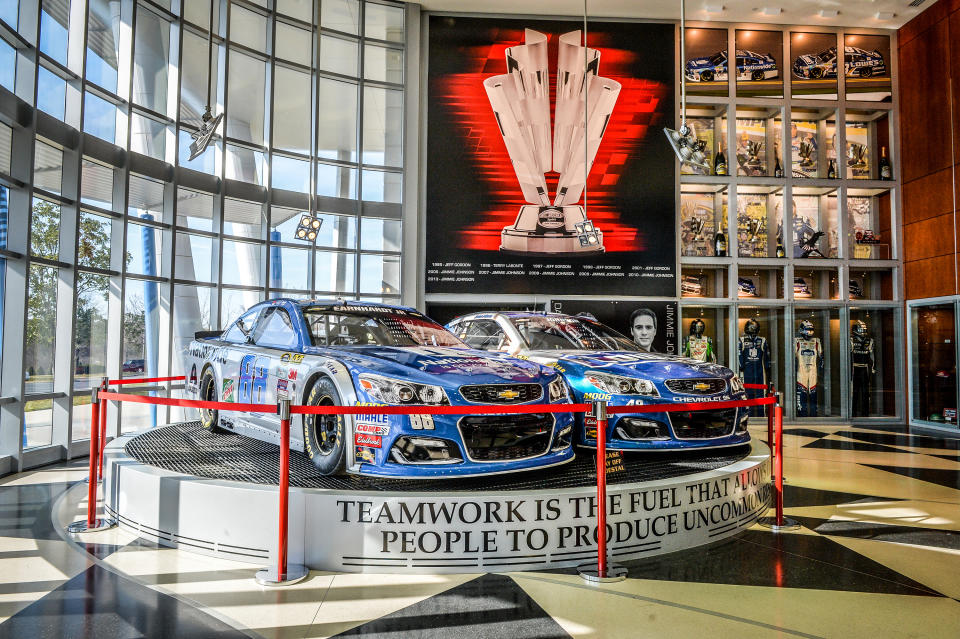
Walk through the front doors of a large race shop like Hendrick Motorsports or Penske Racing and you'll see race cars galore. Lots of cars. Stock cars and open-wheel cars, retired cars and cars ready to race, cars that won and cars that crashed. If the shop is a good one, there are lots of trophies as well. The largest racing operations, like Hendrick's, occupy entire corporate campuses, with separate buildings for engine building, transmission and suspension construction, body shops, paint shops, and even weight rooms and race-simulation environments for pit crews. Rope partitions and glass walls separate visitors from the actual working area where mechanics in team uniforms make painstaking adjustments to the engine, body, and shocks.
First-time visitors to modern race shops tend to be surprised when they walk in. They expect fast, loud, brutal machines like race cars to be built and tuned in environments filled with oil, smoke, and guys with Jughead caps lying under cars on creepers. In fact, today's race shop is bright and sterile, a clean room with nary an oil spot to be seen. When I visited, the air didn't smell of gasoline, exhaust, or nitromethane. There are more guys staring at the readouts of digital test meters than feeling gasoline for gumminess, more CNC machines and 3D printers than sparking arc welders and chop saws-at least in the places the public can visit.
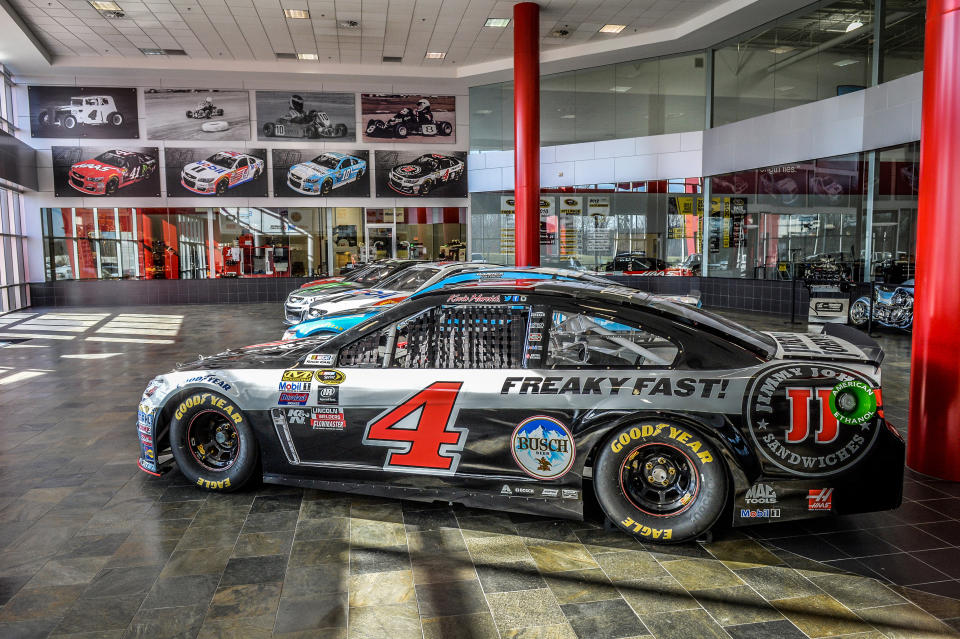
The race shops produce cars that "are pretty much flying missiles, almost flying down the race track and then avoiding the walls at the end of the straightaways," says Charlotte Speedway's Lenny Batycki. "The cars are aerodynamically sound and perfectly tuned for the track." Such perfect machines must be crafted in perfectly designed environments-hence the move toward technical precision over raw power. Not quite the way it was when Richard Petty and Junior Johnson raced off-the-lot production cars. Many of those old-time race shops would fit inside the gift shops at modern race HQs.
Oh, the gift shops. No entity as dedicated to corporate sponsorship as is 21st-century NASCAR is complete without kitschy T-shirts, ball caps, and key chains. The colossal gift shops at team headquarters are also replete with items specific to the world of motor racing. Among the most popular are the die-cast replicas of race cars that my kart-racing mentor Howard Hitchcock makes. Some replica car models are astonishingly detailed, and they gleam with high-end, specially plated finishes.
You also can come home with a real race car, or at least a few parts of it. Those with little money and no closet space can get a few used lug nuts. But if you have extra room in your car trunk, you can bring home a used Goodyear Eagle racing tire or two. Each Eagle is 65 pounds of track-worn, soft, tread-free racing rubber, a perfect souvenir for the rare racing aficionado with display space for worn rubber. More popular than tires are the sheet-metal car relics on sale. Many race-shop gift stores sell hunks of freshly cut, sponsor-decal-clad hoods, fenders, and roofs of cars raced by big-name drivers. For less than $200, the quarter panel off Kasey Kahne's Chevy can be yours.
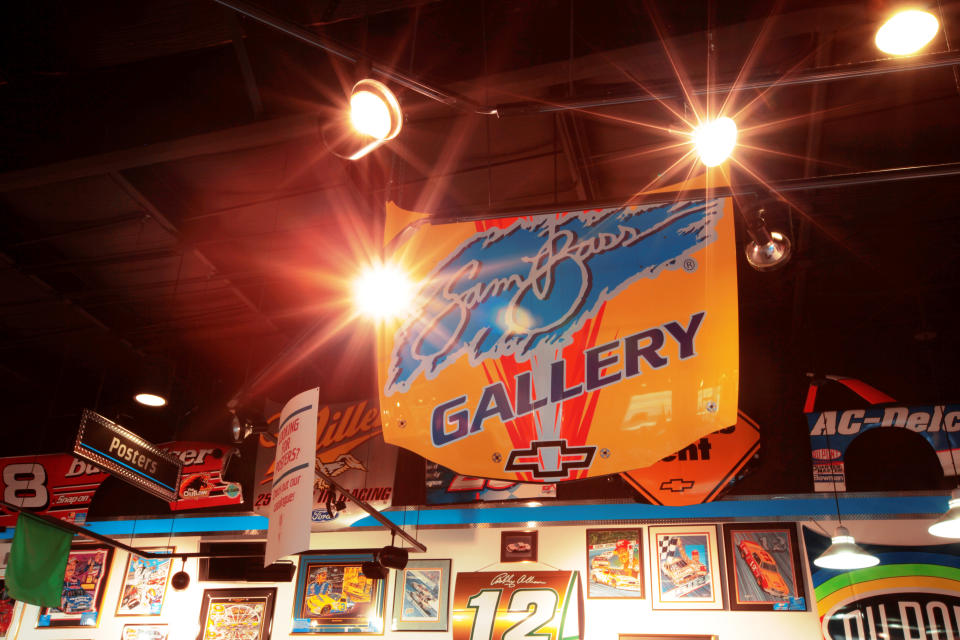
Merch is a big enough business here to produce its own celebrities, like artist Sam Bass. "I went to my first race at age seven and was fascinated by the speed and excitement," Bass told me at his studio next to the racetrack. "The first night I ever saw a race, I told my uncles that I wanted to be a NASCAR artist." Now Bass's work appears all over carburetor country, from the posters sold in gift stores to the covers of race-day programs to the paint schemes of the race cars themselves.
Bass says he portrays "the drivers as I see them: larger-than-life comic-book-style superheroes." Accordingly, his style is full of bold colors and heroic poses, more like Jack Kirby than Ed "Big Daddy" Roth. Bass is adept at giving the cars he draws the look of moving fast, a hard feat to pull off in a motionless, two-dimensional painting. "It's not the way the car is drawn as much as it is the road that gives the look of speed," Bass says. Some roads, like racetracks, just look fast.
The Speedway
Charlotte Motor Speedway is one fast road. Each year it hosts numerous motorsports events, including the longest NASCAR race on the circuit, the Coca-Cola 600, and the All-Star Race with its million-dollar first prize. Within the same complex as the speedway is the ZMax drag strip, which has the world's only four-lane, all-concrete drag strip, as well as a top-notch short oval dirt track. From drag racing to late models to specialty classes like Legend and Bandolero, there's a type of motor race for just about everybody.
Certainly, stock car racing on asphalt is the most well known. But to many around here, short-track racing on Carolina dirt is the real McCoy; noisy, dusty, and raucous, pure of heart and unencumbered by big-money sponsorships. Sprint car racing, one of the more popular short-track race classifications, features tiny cars with ungodly horsepower-to-weight ratios and outfitted with oddly unmatched tires. Some sprint cars pack 1000 horsepower into a 1,400-pound chassis (driver included) and are kept from going airborne only by the addition of giant inverted wings, or spoilers, that press the car down as it circles the track.
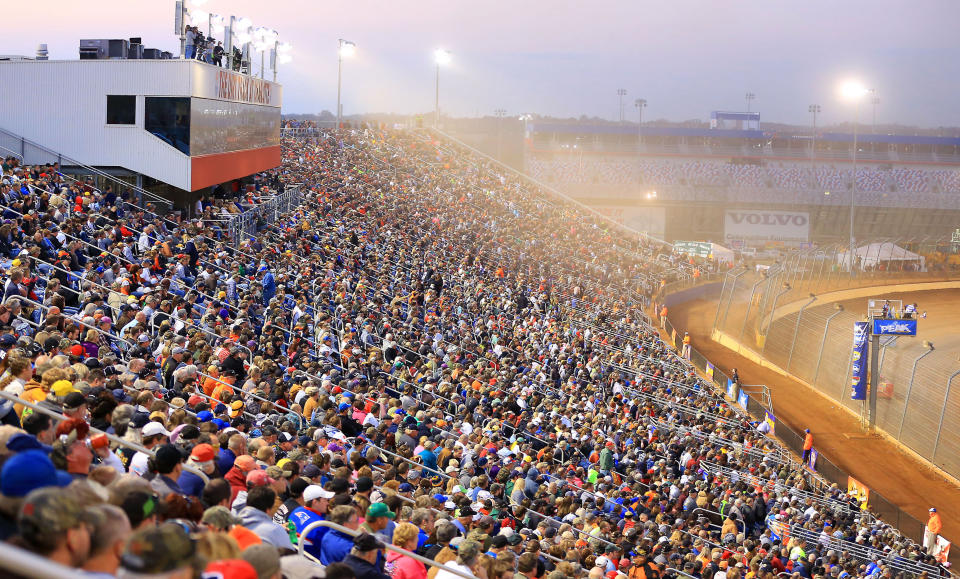
On the hot summer night I attended the sprint races, I watched the cars run the track, their slick tires tearing into the moistened dirt, kicking up an auburn haze that nearly enveloped the grandstand. That made it tough at times to see the action in the back stretch clearly. Yet, nearly every fan in the packed grandstand seemed fully engaged, doing what they could to make themselves audible over the roar of the 20 or so kilo-horsepower engines with throttles completely open.
Nearly 14,000 fans can and do pack into the stands at the dirt track for the biggest events. That's quite a lot, considering that few if any drivers are well known outside the rather arcane world of dirt-track racing and, by professional sports standards, the sponsorship and advertising budgets are minor league.
But the big track at Charlotte has 135,000 seats, and filling those seats requires real effort. It's been tough recently as NASCAR has experienced a sizable downturn in attendance over the past ten years or so. Despite the drop, there are still an awful lot of dedicated fans who embrace NASCAR as not just a sport but a lifestyle. Such devotion is due in part to the elaborate marketing and programming that makes the fan experience at big races unique.
For fans, the race day begins very early-way, way before the first driver starts his engine.
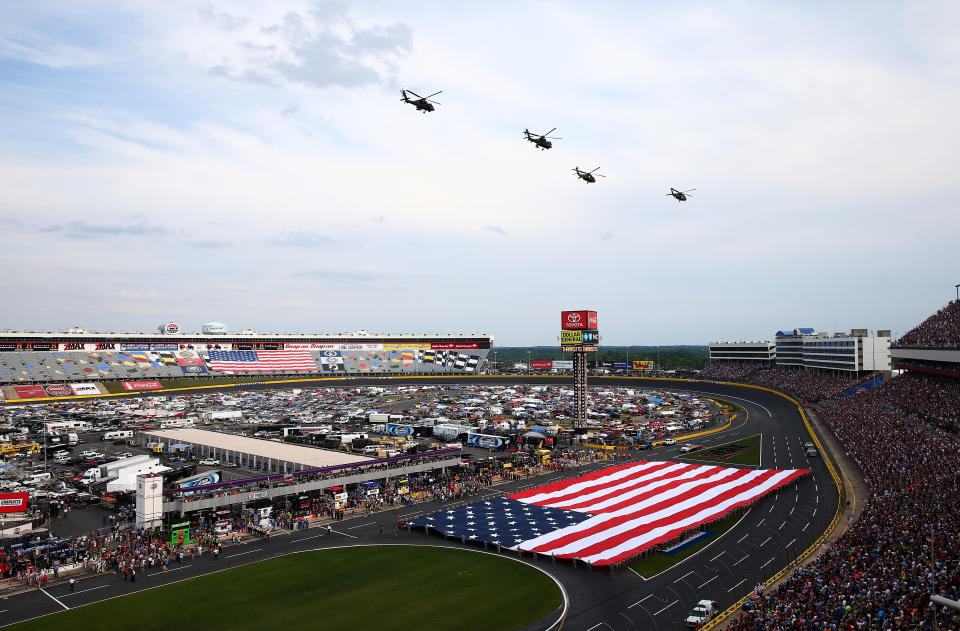
"I think I actually like this better than the race itself," one racegoer told me between sips of beer before the race. He was referring to the elaborate activities that precede every race. Just the pageantry leading up to the singing of the national anthem is as real and loud as you'd imagine. At this year's Coca-Cola 600, 600 soldiers from Fort Bragg marched in formation upon the track surface to the sound of a military band while commandos rappelled down from Black Hawk helicopters performing, described in the program as "an aerial re-enactment of an invasion." That was followed by parachutists floating onto the speedway infield while waving garage-door-size American flags. Then four F-15 jets skimmed over the speedway while an artillery battery manning howitzers positioned behind the back straightaway blasted away. Things continued in this manner until the requisite country-western recording star sang the national anthem.
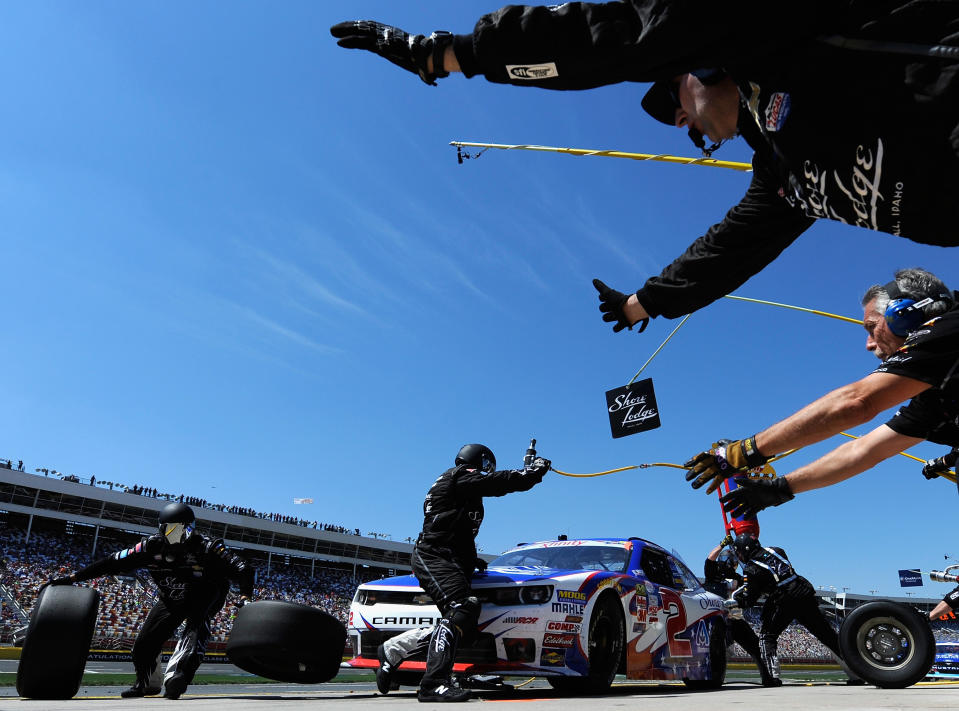
To attend a race, any race, from sprint car to stock car, is to engage all your senses. The cars are brightly colored, insanely fast-moving things, big enough to see clearly, yet the scale of the track makes it possible to take in multiple vistas from any seat. The loudness is extraordinary, pushing 130 decibels trackside. It's something that's felt as keenly as it's heard. Traces of hot rubber and exhaust permeate the entire facility. Add in the taste of a cold beverage on a hot, humid day and you've got an overwhelming sensory experience.
The very best moment, for me at least, is the beginning of the race when the pace car exits the track and unleashes the combined 36,000 horsepower of 40 cars screaming unmuffled into the first turn.
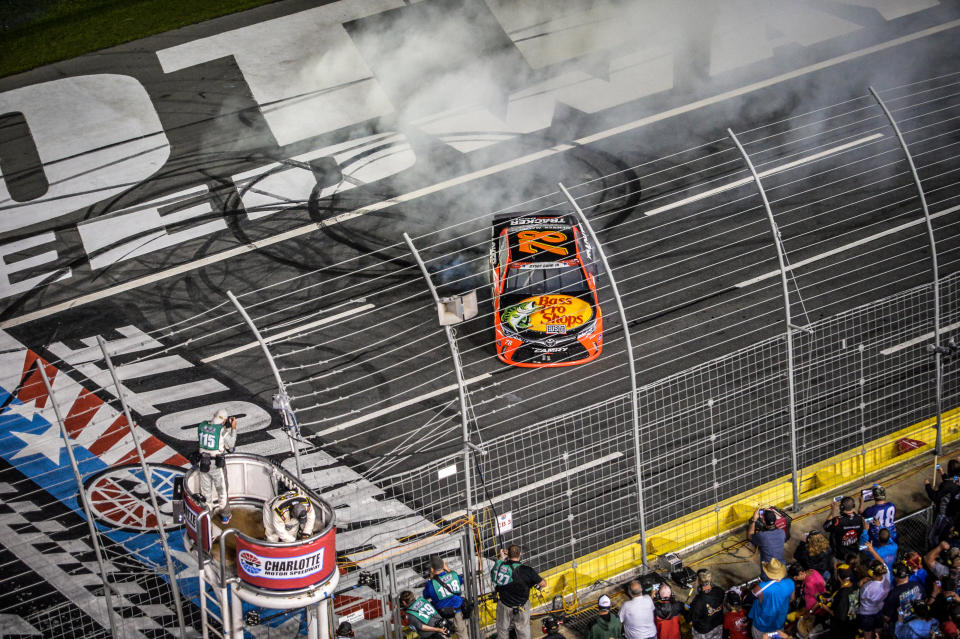
Spectacle and competition are a natural, easy-to-appreciate combination. Lots of us simply love speed, and perhaps humans are evolutionarily programmed to do so. Natural selection probably culled the slow from the fast humans early on. It's like Henry Ford said: Auto racing began five minutes after the second car was built.
You Might Also Like

